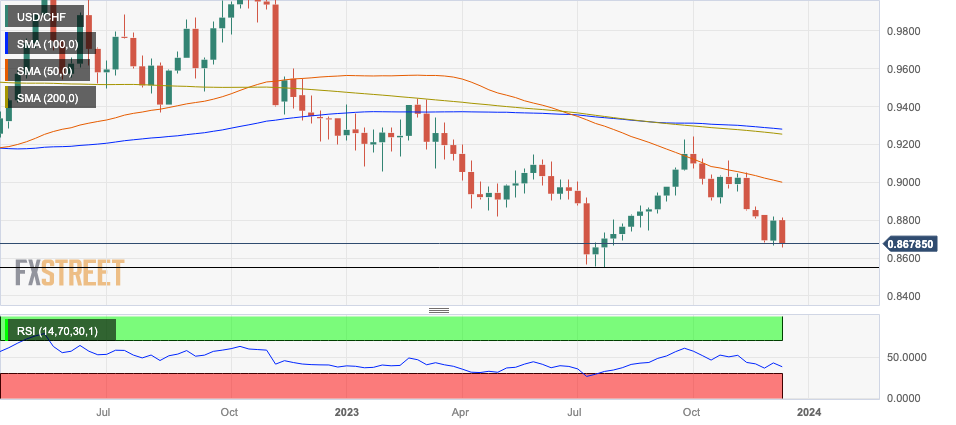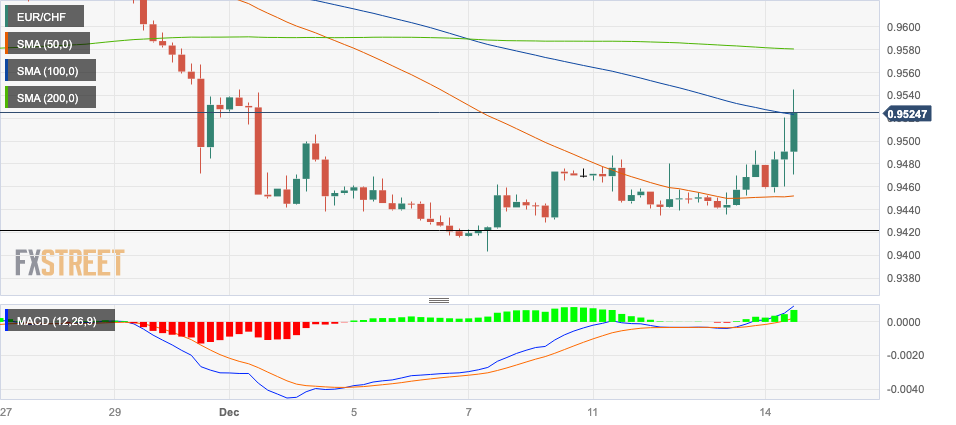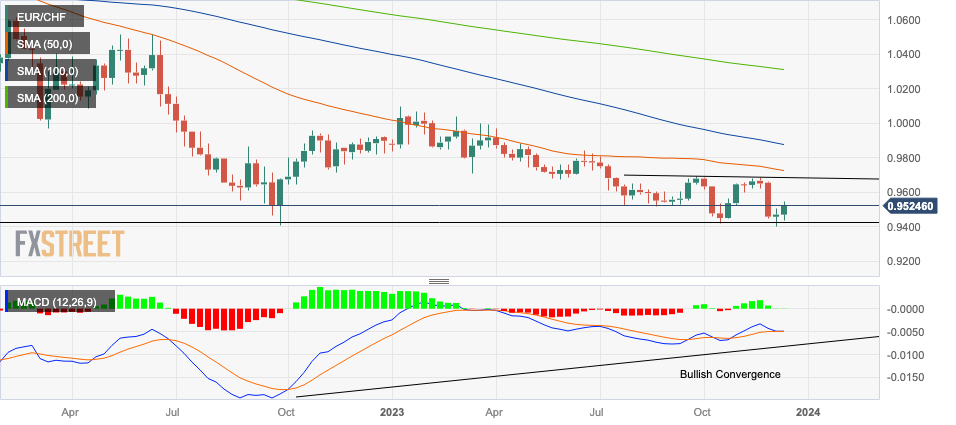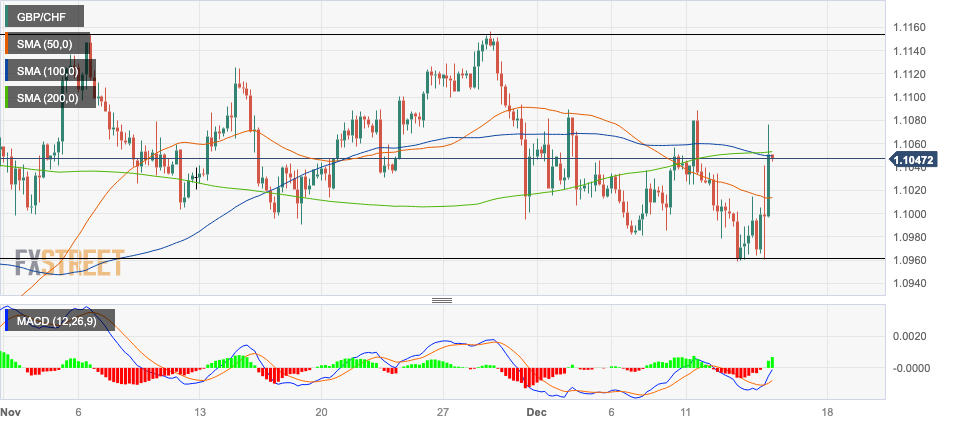- The Swiss Franc trades mixed after a throng of meetings by the world’s leading central banks.
- The Federal Reserve, Swiss National Bank, European Central Bank and Bank of England have all had meetings in the last 24 hours.
- Swiss Franc is up versus the US Dollar but lower against the Euro and the Pound.
The Swiss Franc (CHF) traded mixed on Thursday after policy meetings by all the major central banks provided traders with more intel on the future course of interest rates – a key driver of currency valuations. The Swissie has gained 0.57% against the US Dollar at the time of writing, while it has approximately 0.5% to both the Euro and British Pound.
The first c-bank to kick off was the Swiss National Bank (SNB). The SNB left interest rates unchanged at 1.75% and lowered its inflation forecasts, an indication it might also lower interest rates in the future.
However, Swiss National Bank Chairman Thomas Jordan tried to dampen speculation of interest rate cuts by stating the bank would not be cutting rates as global “uncertainty remains high.” The general consensus was dovish (that interest rates will fall). The expectation of lower interest rates weakens a currency since it leads to lower capital inflows.
Nevertheless, the Swiss Franc is trading higher versus the US Dollar after the Federal Reserve (Fed) struck an even more dovish tone at its meeting on Wednesday, when the Chairman of the Federal Reserve, Jerome Powell, said talk of interest rate cuts had come “into view”.
The Swissie is lower against both the Euro and the Pound after neither of their central banks discussed cutting interest rates at all, suggesting rather that they might remain higher for longer.
Daily digest market movers: Swiss Franc gains against weakening USD on dovish Fed
- The Swiss Franc rose versus the US Dollar (USD) on Thursday after Fed Chair Powell signaled monetary policy tightening is likely over as inflation is falling faster than expected. He added that a discussion of interest rate cuts at the Fed meeting had come “into view.” It is the first time he has mentioned cuts being discussed during this tightening cycle.
- Whilst both the Fed and SNB lowered their inflation forecasts, Powell (unlike Jordan) mentioned the subject of interest rate cuts had been discussed, which likely led to the more dovish outlook for the Fed rather than the SNB.
- This explains the USD’s weakness versus the Swiss Franc.
Swiss Franc technical analysis: USD/CHF resumes broader downtrend
USD/CHF – the number of Swiss Francs that one US Dollar can buy – corrects all the way back down to the December lows.
The pair is arguably in a downtrend now on all major time frames, suggesting bears are fully in charge and further weakness is probable.
US Dollar vs Swiss Franc: Weekly Chart
If a break below the December lows holds, the pair may well continue falling toward the next target at the July 2023 lows of 0.8552. Beyond that, further weakness could drag the pair down to 0.8500 and beyond.
The Relative Strength Index (RSI) is not yet oversold, indicating more downside is possible before bears have had enough.
Daily digest market movers: Swiss Franc takes battering vs Euro as Lagarde turns hawkish
- The Swiss Franc weakened against the Euro on Thursday after the President of the European Central Bank (ECB), Christine Lagarde, said the governing council did not “at all” discuss rate cuts.
- At its meeting on Thursday, the ECB announced that it had decided to leave key rates unchanged. With this decision, the interest rate on the main refinancing operations, the marginal lending facility and the deposit facility stayed at 4.50%, 4.75% and 4.00%, respectively.
- The Euro rose on Lagarde’s not discussed “at all” comments, as these suggest the ECB is far from reducing interest rates.
Swiss Franc technical analysis: EUR/CHF trends higher in the short-term, but longer-term horizon still bearish
EUR/CHF – the number of Swiss Francs that one Euro can buy – is shooting higher on Thursday.
The pair has reversed trend in the short term, suggesting bulls now have the upper hand on that time horizon. EUR/CHF has broken above the 0.9487 December 11 high, reconfirming the uptrend. It has now met its first immediate upside target at 0.9540, where a confluence of resistance levels sits.
This tough resistance ceiling would have to be battered down for the short-term bullish trend to continue.
Euro vs Swiss Franc: 4-hour Chart
The medium-term trend (daily chart below), however, is still either sideways or bearish, suggesting over-eager bulls should operate with caution.
Nevertheless, the MACD momentum indicator is about to execute a potentially bullish crossover, indicating strength may come.
Euro vs Swiss Franc: Daily Chart
A decisive break above 0.9600 would probably indicate a break above the resistance cap from the 50 and 100 Simple Moving Averages (SMA) and leave the way open to further upside to the top of the range at around 0.9685.
The long-term view on the weekly chart below shows a more bearish picture and the pair bouncing around multi-year lows just above 0.9400.
The MACD momentum indicator, however, is supporting a more positive outlook by forming a long-term bearish convergence with price. This happens when price falls to lower lows but MACD does not mirror it. It is a sign of waning bearish momentum and underlying strength.
Euro vs Swiss Franc: Weekly Chart
A decisive weekly-bar break below the 0.9403 multi-year low would reconfirm the long-term bearish bias and see prices fall into uncharted territory, with major whole numbers then expected to provide support at 0.9300, 0.9200 and so on.
A break above the range highs at 0.9685 would be required to at least raise the possibility of a reversal in the downtrend.
Daily digest market movers: Sterling rises against Swiss Franc after ‘hawkish’ BoE meeting
- The Swiss Franc weakened against the Pound Sterling (GBP) on Thursday after the Bank of England (BoE) noted that inflation remains persistently high, suggesting rates will also need to stay high.
- The Bank of England (BoE) Monetary Policy Committee (MPC) voted by a majority of 6–3 to maintain the Bank Rate at 5.25% on Thursday. Three members preferred to increase the Bank Rate by 25 basis points.
- BoE policy makers believed the current monetary policy stance is restrictive, although they reaffirmed their intention to maintain rates higher for longer.
- Bank of England Governor Andrew Bailey did say he “hopes” they are at the top of the rate cycle.
- Average Earnings in the UK remain relatively high, suggesting inflation may remain sticky.
- The problem of wage inflation is exacerbated by a lack of labor market spare capacity following Brexit.
- Recent data showed Average Earnings Excluding Bonuses slowed slightly to 7.3%, and Average Earnings Including Bonuses slowed slightly to 7.4%.
- Whilst lower than forecast and previous figures these are high given the MPC’s Bank Rate of 5.25%.
Swiss Franc technical analysis: GBP/CHF back in the middle of its range
GBP/CHF – the number of Swiss Francs that one Pound Sterling can buy – continues randomly bobbing around in a month-long range on the 4-hour chart used to analyze the short-term trend. It is also sideways on long-term time frames.
On the 4-hour chart the pair has reversed yet again and is bouncing higher after briefly breaching the range lows just prior to the BoE meeting. It is now roughly back plum in the middle of the range.
Pound Sterling vs Swiss Franc: 4-hour Chart
The MACD has recently crossed above its signal line whilst below the zero line, which is a bullish short-term signal and could signify more gains to come.
The recovery and break above the 1.1040 level has provided some bullish confirmatory evidence a new leg higher is underway, toward a target at 1.1155 and the range high, although the pair remains volatile and difficult to judge.
SNB FAQs
The Swiss National Bank (SNB) is the country’s central bank. As an independent central bank, its mandate is to ensure price stability in the medium and long term. To ensure price stability, the SNB aims to maintain appropriate monetary conditions, which are determined by the interest rate level and exchange rates. For the SNB, price stability means a rise in the Swiss Consumer Price Index (CPI) of less than 2% per year.
The Swiss National Bank (SNB) Governing Board decides the appropriate level of its policy rate according to its price stability objective. When inflation is above target or forecasted to be above target in the foreseeable future, the bank will attempt to tame excessive price growth by raising its policy rate. Higher interest rates are generally positive for the Swiss Franc (CHF) as they lead to higher yields, making the country a more attractive place for investors. On the contrary, lower interest rates tend to weaken CHF.
Yes. The Swiss National Bank (SNB) has regularly intervened in the foreign exchange market in order to avoid the Swiss Franc (CHF) appreciating too much against other currencies. A strong CHF hurts the competitiveness of the country’s powerful export sector. Between 2011 and 2015, the SNB implemented a peg to the Euro to limit the CHF advance against it. The bank intervenes in the market using its hefty foreign exchange reserves, usually by buying foreign currencies such as the US Dollar or the Euro. During episodes of high inflation, particularly due to energy, the SNB refrains from intervening markets as a strong CHF makes energy imports cheaper, cushioning the price shock for Swiss households and businesses.
The SNB meets once a quarter – in March, June, September and December – to conduct its monetary policy assessment. Each of these assessments results in a monetary policy decision and the publication of a medium-term inflation forecast.
- SEO Powered Content & PR Distribution. Get Amplified Today.
- PlatoData.Network Vertical Generative Ai. Empower Yourself. Access Here.
- PlatoAiStream. Web3 Intelligence. Knowledge Amplified. Access Here.
- PlatoESG. Carbon, CleanTech, Energy, Environment, Solar, Waste Management. Access Here.
- PlatoHealth. Biotech and Clinical Trials Intelligence. Access Here.
- Source: https://www.fxstreet.com/news/swiss-franc-pairs-chf-majors-mixed-after-dramatic-24-hours-202312141703








